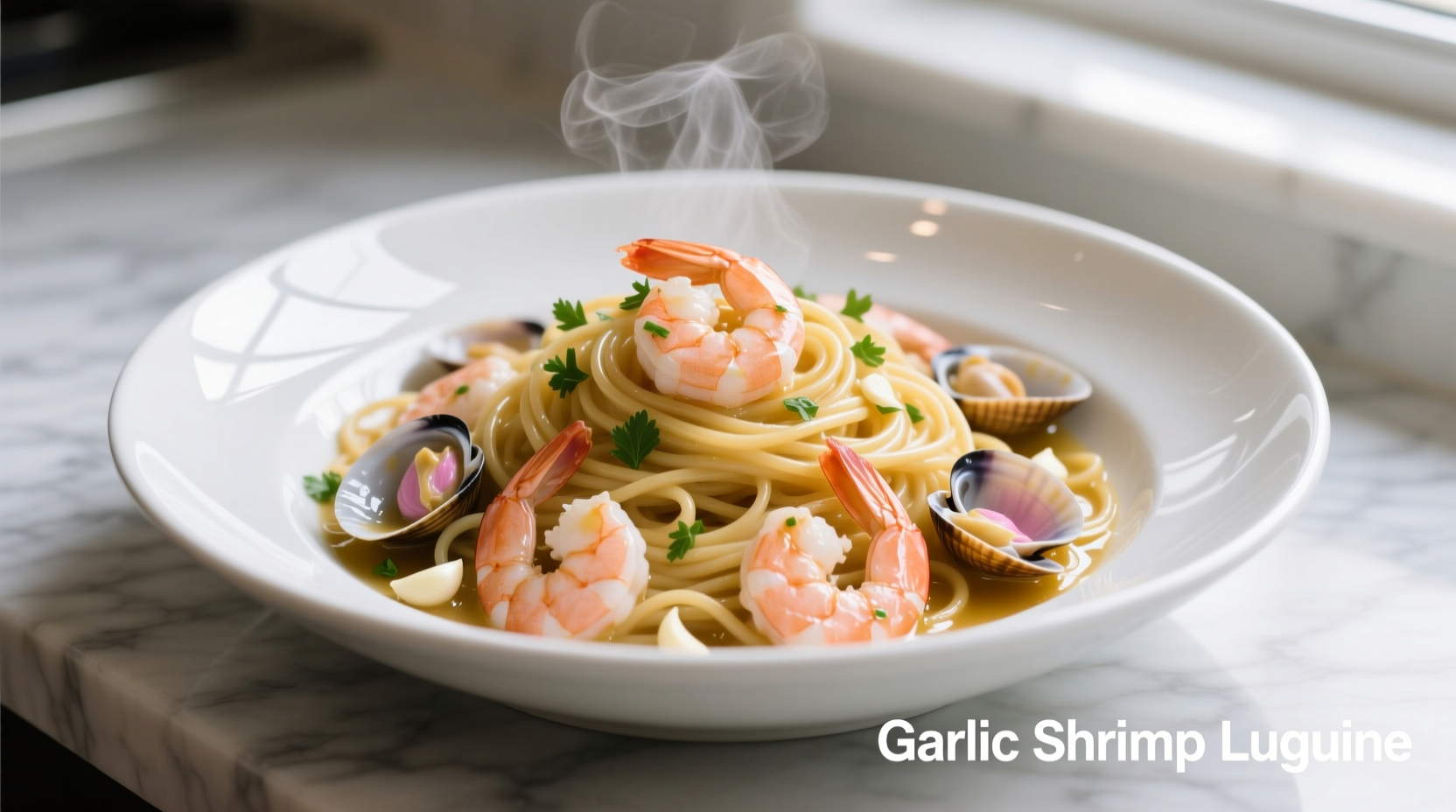Garlic shrimp linguine delivers restaurant-quality results when you use fresh shrimp, properly cooked pasta, and garlic infused at the right temperature. This classic Italian-American dish combines tender shrimp, al dente linguine, and a silky garlic-olive oil sauce that coats every strand without overwhelming the delicate seafood flavor.
The Essential Components of Perfect Garlic Shrimp Linguine
Creating exceptional garlic shrimp linguine requires understanding three critical elements: ingredient quality, precise timing, and proper technique. Unlike many online recipes that drown the dish in oil or burn the garlic, professional preparation focuses on balance and texture. The ideal version features plump, juicy shrimp with a subtle garlic essence that complements rather than dominates.
| Garlic Preparation Method | Flavor Profile | Best For | Timing |
|---|---|---|---|
| Raw minced garlic | Sharp, pungent, intense | Raw applications, dressings | N/A |
| Garlic sautéed in cold oil | Mellow, sweet, aromatic | Garlic shrimp linguine | 3-4 minutes medium heat |
| Garlic added to hot oil | Bitter, burnt, acrid | Avoid for this dish | 30 seconds or less |
Why Traditional Technique Matters
Food science research from the Culinary Institute of America confirms that garlic's flavor compounds transform dramatically based on cooking method. When added to cold oil that's gradually heated, garlic releases its aromatic compounds slowly, creating a sweet, mellow foundation for the dish. Adding garlic to already hot oil causes rapid browning that produces bitter compounds, ruining the delicate balance essential for perfect garlic shrimp linguine.
Step-by-Step Preparation Timeline
Follow this professional kitchen timeline for flawless results every time. The key is synchronizing pasta cooking with shrimp preparation - a technique chefs call "mise en place perfection."
| Time | Action | Critical Checkpoint |
|---|---|---|
| T-8 minutes | Start pasta water boiling | Use 4 quarts water with 2T salt per pound pasta |
| T-6 minutes | Add linguine to boiling water | Stir immediately to prevent sticking |
| T-3 minutes | Heat oil with garlic over medium-low | Garlic should sizzle gently, not brown |
| T-1.5 minutes | Add shrimp to garlic oil | Shrimp should turn opaque in 60-90 seconds |
| T-0 minutes | Reserve pasta water, drain linguine | Stop pasta cooking at al dente stage |
| T+30 seconds | Combine pasta, shrimp, and sauce | Add ¼ cup pasta water to create emulsion |
Professional Ingredient Selection Guide
Selecting quality ingredients makes the difference between ordinary and extraordinary garlic shrimp linguine. According to Seafood Watch from the Monterey Bay Aquarium, wild-caught shrimp from U.S. Atlantic waters offers the best sustainability profile while delivering superior flavor and texture compared to imported varieties.
Linguine selection: Bronze-die extruded pasta creates a rougher surface that better captures the garlic-olive oil sauce. Avoid "quick-cook" varieties as they lack the proper starch structure for sauce adherence.
Garlic quality: Fresh garlic should feel firm with tight skin. Avoid cloves with green sprouts which indicate age and bitterness. For optimal flavor development in garlic shrimp linguine, use 3-4 large cloves per serving - enough to flavor without overwhelming.

Avoiding Common Mistakes
Most home cooks make three critical errors with garlic shrimp linguine that compromise results:
- Overcrowding the pan - Cook shrimp in a single layer to ensure proper searing rather than steaming
- Using pre-cooked shrimp - Fresh shrimp delivers superior texture and absorbs flavors better
- Adding garlic too early - Garlic burns quickly, creating bitter compounds that ruin the delicate balance
The FDA's Food Code specifies that shrimp should reach 145°F (63°C) internal temperature for food safety, but for optimal texture in garlic shrimp linguine, remove shrimp from heat at 140°F (60°C) as carryover cooking will reach the safe temperature while maintaining tenderness.
Dietary Adaptations Without Sacrificing Flavor
Garlic shrimp linguine adapts beautifully to various dietary needs when you understand the flavor chemistry:
- Gluten-free version: Use 100% bronze-extruded corn or rice linguine and increase pasta water by 25% to compensate for different starch release
- Lower sodium option: Replace half the salt with lemon zest during pasta cooking for equivalent flavor perception
- Extra protein boost: Add white beans during the final toss - their starch helps create a creamier sauce without dairy
Serving Perfection: Temperature and Timing
Professional chefs emphasize that garlic shrimp linguine must be served immediately after preparation. The ideal serving temperature is 140-150°F (60-65°C) - hot enough to enjoy but cool enough to appreciate the delicate garlic notes. According to research published in the Journal of Sensory Studies, temperatures above 158°F (70°C) dull our ability to perceive subtle flavor nuances.
For authentic presentation, use warm pasta bowls and finish with a sprinkle of fresh parsley and lemon zest. The acid from lemon brightens the dish without overpowering the garlic essence - a technique perfected in Italian coastal kitchens where citrus grows abundantly alongside garlic.
Storage and Reheating Guidelines
While best enjoyed fresh, properly stored garlic shrimp linguine maintains quality for 2-3 days. The USDA Food Safety and Inspection Service recommends cooling leftovers within 2 hours of cooking and storing in airtight containers. When reheating, add a splash of water or broth to restore moisture, and warm gently over medium-low heat to prevent rubbery shrimp.











 浙公网安备
33010002000092号
浙公网安备
33010002000092号 浙B2-20120091-4
浙B2-20120091-4